Johan Rohdin
Bayesian Learning for Domain-Invariant Speaker Verification and Anti-Spoofing
Jun 09, 2025Abstract:The performance of automatic speaker verification (ASV) and anti-spoofing drops seriously under real-world domain mismatch conditions. The relaxed instance frequency-wise normalization (RFN), which normalizes the frequency components based on the feature statistics along the time and channel axes, is a promising approach to reducing the domain dependence in the feature maps of a speaker embedding network. We advocate that the different frequencies should receive different weights and that the weights' uncertainty due to domain shift should be accounted for. To these ends, we propose leveraging variational inference to model the posterior distribution of the weights, which results in Bayesian weighted RFN (BWRFN). This approach overcomes the limitations of fixed-weight RFN, making it more effective under domain mismatch conditions. Extensive experiments on cross-dataset ASV, cross-TTS anti-spoofing, and spoofing-robust ASV show that BWRFN is significantly better than WRFN and RFN.
Fine-tune Before Structured Pruning: Towards Compact and Accurate Self-Supervised Models for Speaker Diarization
May 30, 2025Abstract:Self-supervised learning (SSL) models like WavLM can be effectively utilized when building speaker diarization systems but are often large and slow, limiting their use in resource constrained scenarios. Previous studies have explored compression techniques, but usually for the price of degraded performance at high pruning ratios. In this work, we propose to compress SSL models through structured pruning by introducing knowledge distillation. Different from the existing works, we emphasize the importance of fine-tuning SSL models before pruning. Experiments on far-field single-channel AMI, AISHELL-4, and AliMeeting datasets show that our method can remove redundant parameters of WavLM Base+ and WavLM Large by up to 80% without any performance degradation. After pruning, the inference speeds on a single GPU for the Base+ and Large models are 4.0 and 2.6 times faster, respectively. Our source code is publicly available.
Analysis of ABC Frontend Audio Systems for the NIST-SRE24
May 21, 2025Abstract:We present a comprehensive analysis of the embedding extractors (frontends) developed by the ABC team for the audio track of NIST SRE 2024. We follow the two scenarios imposed by NIST: using only a provided set of telephone recordings for training (fixed) or adding publicly available data (open condition). Under these constraints, we develop the best possible speaker embedding extractors for the pre-dominant conversational telephone speech (CTS) domain. We explored architectures based on ResNet with different pooling mechanisms, recently introduced ReDimNet architecture, as well as a system based on the XLS-R model, which represents the family of large pre-trained self-supervised models. In open condition, we train on VoxBlink2 dataset, containing 110 thousand speakers across multiple languages. We observed a good performance and robustness of VoxBlink-trained models, and our experiments show practical recipes for developing state-of-the-art frontends for speaker recognition.
Leveraging Self-Supervised Learning for Speaker Diarization
Sep 14, 2024



Abstract:End-to-end neural diarization has evolved considerably over the past few years, but data scarcity is still a major obstacle for further improvements. Self-supervised learning methods such as WavLM have shown promising performance on several downstream tasks, but their application on speaker diarization is somehow limited. In this work, we explore using WavLM to alleviate the problem of data scarcity for neural diarization training. We use the same pipeline as Pyannote and improve the local end-to-end neural diarization with WavLM and Conformer. Experiments on far-field AMI, AISHELL-4, and AliMeeting datasets show that our method substantially outperforms the Pyannote baseline and achieves performance comparable to the state-of-the-art results on AMI and AISHELL-4. In addition, by analyzing the system performance under different data quantity scenarios, we show that WavLM representations are much more robust against data scarcity than filterbank features, enabling less data hungry training strategies. Furthermore, we found that simulated data, usually used to train endto-end diarization models, does not help when using WavLM in our experiments. Additionally, we also evaluate our model on the recent CHiME8 NOTSOFAR-1 task where it achieves better performance than the Pyannote baseline. Our source code is publicly available at https://github.com/BUTSpeechFIT/DiariZen.
BUT Systems and Analyses for the ASVspoof 5 Challenge
Aug 20, 2024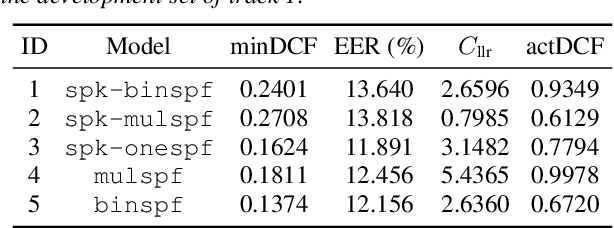
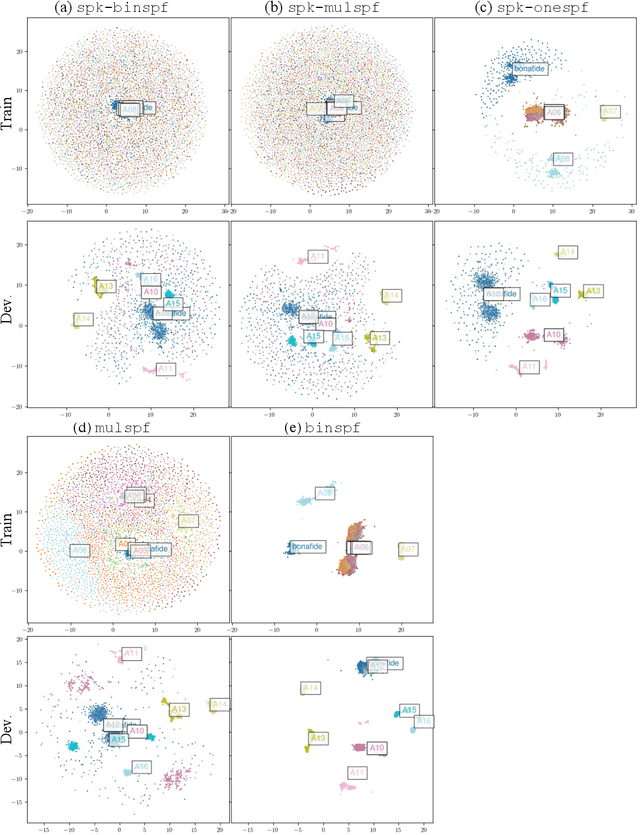
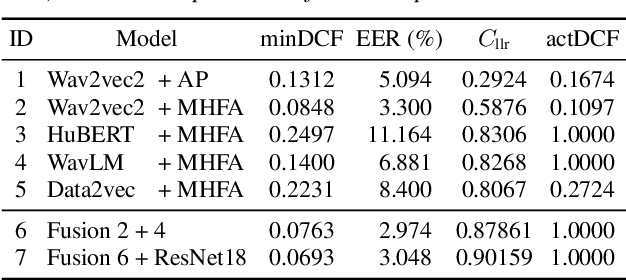
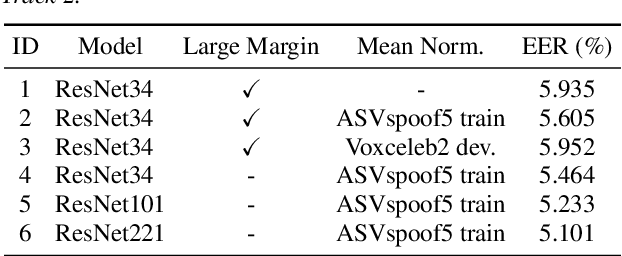
Abstract:This paper describes the BUT submitted systems for the ASVspoof 5 challenge, along with analyses. For the conventional deepfake detection task, we use ResNet18 and self-supervised models for the closed and open conditions, respectively. In addition, we analyze and visualize different combinations of speaker information and spoofing information as label schemes for training. For spoofing-robust automatic speaker verification (SASV), we introduce effective priors and propose using logistic regression to jointly train affine transformations of the countermeasure scores and the automatic speaker verification scores in such a way that the SASV LLR is optimized.
Challenging margin-based speaker embedding extractors by using the variational information bottleneck
Jun 18, 2024

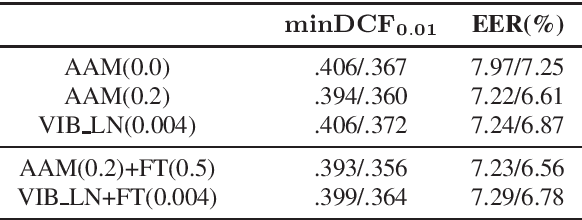
Abstract:Speaker embedding extractors are typically trained using a classification loss over the training speakers. During the last few years, the standard softmax/cross-entropy loss has been replaced by the margin-based losses, yielding significant improvements in speaker recognition accuracy. Motivated by the fact that the margin merely reduces the logit of the target speaker during training, we consider a probabilistic framework that has a similar effect. The variational information bottleneck provides a principled mechanism for making deterministic nodes stochastic, resulting in an implicit reduction of the posterior of the target speaker. We experiment with a wide range of speaker recognition benchmarks and scoring methods and report competitive results to those obtained with the state-of-the-art Additive Angular Margin loss.
DiaCorrect: Error Correction Back-end For Speaker Diarization
Sep 15, 2023



Abstract:In this work, we propose an error correction framework, named DiaCorrect, to refine the output of a diarization system in a simple yet effective way. This method is inspired by error correction techniques in automatic speech recognition. Our model consists of two parallel convolutional encoders and a transform-based decoder. By exploiting the interactions between the input recording and the initial system's outputs, DiaCorrect can automatically correct the initial speaker activities to minimize the diarization errors. Experiments on 2-speaker telephony data show that the proposed DiaCorrect can effectively improve the initial model's results. Our source code is publicly available at https://github.com/BUTSpeechFIT/diacorrect.
Training Speaker Embedding Extractors Using Multi-Speaker Audio with Unknown Speaker Boundaries
Mar 29, 2022
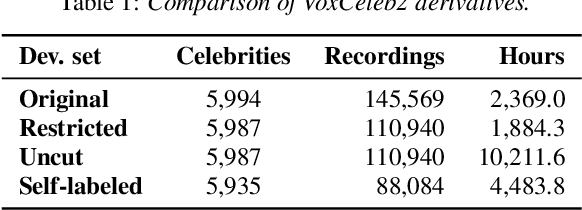

Abstract:In this paper, we demonstrate a method for training speaker embedding extractors using weak annotation. More specifically, we are using the full VoxCeleb recordings and the name of the celebrities appearing on each video without knowledge of the time intervals the celebrities appear in the video. We show that by combining a baseline speaker diarization algorithm that requires no training or parameter tuning, a modified loss with aggregation over segments, and a two-stage training approach, we are able to train a competitive ResNet-based embedding extractor. Finally, we experiment with two different aggregation functions and analyze their behaviour in terms of their gradients.
Analyzing speaker verification embedding extractors and back-ends under language and channel mismatch
Mar 19, 2022
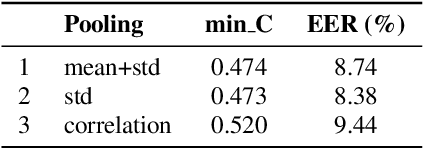

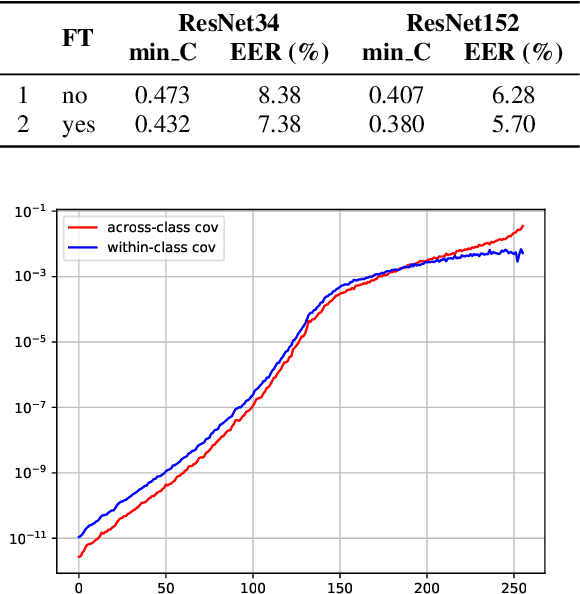
Abstract:In this paper, we analyze the behavior and performance of speaker embeddings and the back-end scoring model under domain and language mismatch. We present our findings regarding ResNet-based speaker embedding architectures and show that reduced temporal stride yields improved performance. We then consider a PLDA back-end and show how a combination of small speaker subspace, language-dependent PLDA mixture, and nuisance-attribute projection can have a drastic impact on the performance of the system. Besides, we present an efficient way of scoring and fusing class posterior logit vectors recently shown to perform well for speaker verification task. The experiments are performed using the NIST SRE 2021 setup.
Speaker embeddings by modeling channel-wise correlations
Apr 06, 2021
Abstract:Speaker embeddings extracted with deep 2D convolutional neural networks are typically modeled as projections of first and second order statistics of channel-frequency pairs onto a linear layer, using either average or attentive pooling along the time axis. In this paper we examine an alternative pooling method, where pairwise correlations between channels for given frequencies are used as statistics. The method is inspired by style-transfer methods in computer vision, where the style of an image, modeled by the matrix of channel-wise correlations, is transferred to another image, in order to produce a new image having the style of the first and the content of the second. By drawing analogies between image style and speaker characteristics, and between image content and phonetic sequence, we explore the use of such channel-wise correlations features to train a ResNet architecture in an end-to-end fashion. Our experiments on VoxCeleb demonstrate the effectiveness of the proposed pooling method in speaker recognition.
 Add to Chrome
Add to Chrome Add to Firefox
Add to Firefox Add to Edge
Add to Edge